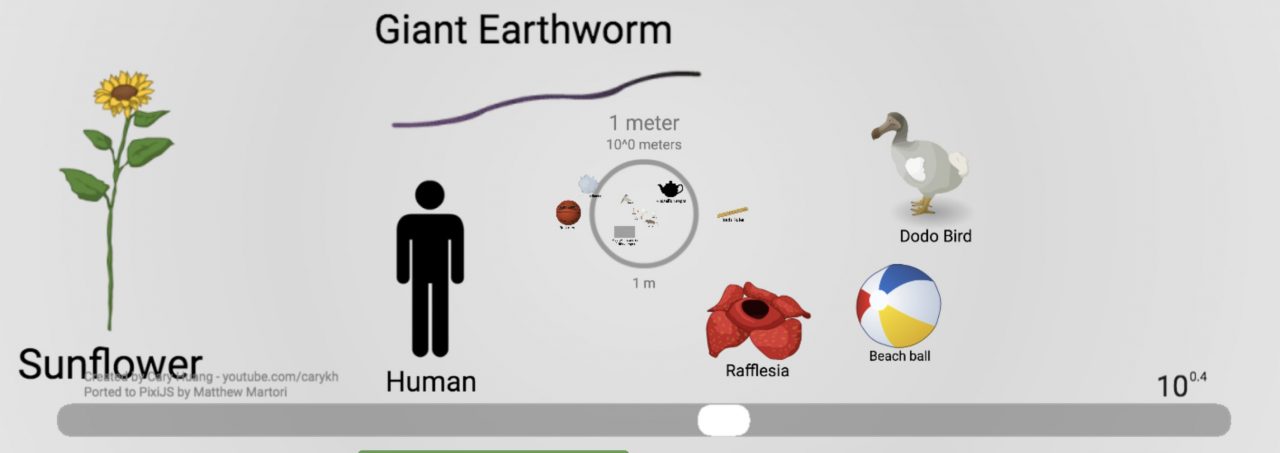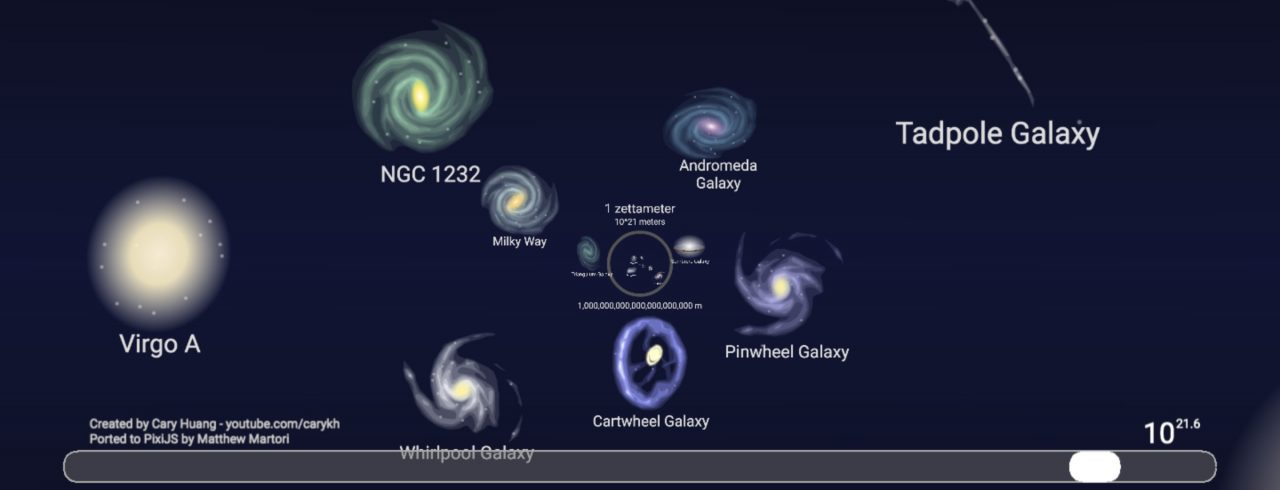Exhibits
The Scale of the Universe
Our Universe is big…very big. We often talk about galaxies and superclusters on the big scale, but what about the small scale stuff of atoms and particles? These are incredibly small objects, so lets get acquainted with the size of different objects in the Universe to appreciate just how difficult it is to detect and work with these particles.
This exhibit takes you through the scale of different objects we study in physics. From the smallest particles, to the largest galaxies, the research being done by astroparticle physicists constitutes quite a large range of sizes. To understand how incredibly small (or incredibly large!) some of the objects are that are studied, let’s compare their size to more everyday objects like people or basketballs using a computer simulation. You can try this on your own device by following this link.

Set the slider to about the middle of the page. Click on the human figure, a small window should pop up giving the average size of the person and some basic information about it. Try clicking on any of the other objects around here or throughout the activity to learn a small bit more about each object! Note the size of the scale in the bottom corner. Try pinching to zoom inwards now. You’ll be seeing the scale of smaller and smaller objects, like small animals, basketballs, and coins.

The further you zoom in, the further down in scale you are looking. You can transport yourself to the size of molecules and DNA, bacteria, light wavelengths, and even atoms! If you keep going you can see inside atoms and see individual protons and neutrons, smaller objects called quarks and neutrinos, and can keep going all the way down to what is called the Planck length. This is the theoretical smallest physical scale that could be achieved. It’s at an astounding 10-33 m, that’s 0.0000…1 with 32 zeros before the 1! However, for scales less than about 10-15 m we have not had confirmed lengths, and the relative sizes and lengths becomes purely theoretical.

Now that we’ve gone small, let’s go the opposite direction and look towards the largest objects! Pinch outwards to zoom out, back to the scale of people, and continue onwards. You can explore the scale of cities, countries, planets, the huge scale of the world of the game Minecraft, and continue out to the stars.
What is the largest star that you can find on this scale? What about the smallest star, called a neutron star?
As the scale is increased to larger sizes, we can see nebulas, which are areas of gas that will one day form stars, then areas of supernovae remnants from dying stars, small dwarf galaxies, and the local group of galaxies – our Milky Way and neighbouring Andromeda galaxy are part of this group, among some 30 other smaller galaxies! Notice the many different sizes, shapes, and types of galaxies to explore and how they look compared to our own Milky Way. Going further and further sets you to clusters and superclusters of galaxies before finally ending our journey on the entire observable Universe.
While zooming to different size ranges, take a look at the scale in the bottom corner. What is the difference between the largest and smallest scales in our Universe? Interestingly, where do the size of humans roughly fit in this range?
The size and age of the Cosmos are beyond ordinary human understanding. Lost somewhere between immensity and eternity is our tiny planetary home.
– Carl Sagan
[expand title=”Teacher Resource – Curriculum Connections”]
Ontario Grade 9 Science (SNC1W)
Particle intrinsic properties :
C2.3 – identify the location, relative mass, and charge of subatomic particles within an atom, using the Bohr-Rutherford model
Solar System members and Universe components :
E2.4 – describe major components of the solar system and the universe and compare their characteristics
Sizes, distances, and units used for the Solar System :
E2.5 – quantify distances in the solar system and the universe by applying an understanding of relative distances and sizes and using appropriate units of measure
Ontario Grade 12 Physics (SPH4U)
Standard Model particle components :
F3.4 – describe the standard model of elementary particles in terms of the characteristics of quarks, hadrons, and field particles
Ontario Grade 12 Earth and Space Science (SES4U)
Scale of the Universe and distances :
B3.2 – explain the scale of distances between celestial bodies and the methods astronomers use to determine these distances
Solar System components :
C3.1 – explain the composition of the Solar System (e.g., the Sun, terrestrial inner planets, the asteroid belt, gas giant outer planets, the Kuiper belt, the scattered disk, the heliopause, the Oort cloud), and describe the characteristics of each component
Physical properties comparisons of astronomical objects :
C3.6 – compare Earth with other objects in the Solar System with respect to properties such as mass, size, composition, rotation, magnetic field, and gravitational field
[/expand]
